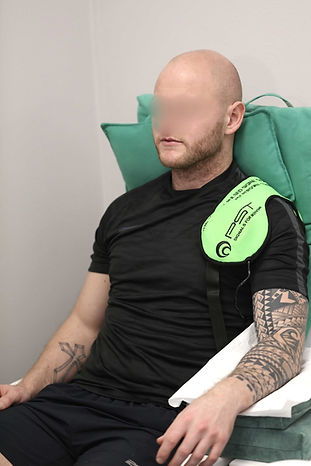Contraindication to PST Thane Dr Sahil's Advanced Physiotherapy clinic

PST treatment -How does it work?
Research has shown that when stress is placed on a joint, a lower power electric signal is created. This natural signal tells the body to repair the damaged or worn tissue and to maintain the health and proper functioning of the joint. Sometimes, the signal is disturbed as a result of aging, injury or disease. When this happens, the body is unable to repair the damage itself. This results in pain, inflammation and loss of proper function in the joint.
Benefits to patients
PST has a success rate of 80% – 83% with patients experiencing significant improvement with reduced pain and improved joint function.
PST has been used successfully all around the world by prominent professional athletes, amateur athletes, older people and patients who have had their quality of life compromised by Arthritis, back pain, Osteoporosis, Sports-Type Injuries and repetitive strain injuries. It is not relevant whether the patient is old or young or whether the defect is a result of age, injury, chronic degeneration or inflammatory disease; PST is effective nonetheless. View the full list of Treatable Conditions.
Studies and the treatment of thousands of patients have shown that over 83% of patients experience a reduction in pain and inflammation, combined with an increase in physical function. Some patients find themselves free of all symptoms following the treatment. Others find their symptoms greatly reduced.
Many patients are able to reduce or even discontinue their pain medication. Many have reported being able to return to normal routine activities, and many are able to participate in their favorite sports.
The biggest benefit for many patients is that PST can save them the expense, pain and inherent risks of surgery.
What to expect during the treatment session ?
As PST is a non-invasive procedure, any type of clothing can be worn during treatment. The patient will sit or lie (depending on the area being treated) in a specially developed chair or bed. The joint or area to be treated is carefully positioned within the PST device. It is necessary to keep the area being treated completely still for the hour of treatment.
The procedure involves nine to twelve 1-hour treatments, conducted on consecutive days. If necessary, an interruption of less than 2 days (48 hours) is authorised after the completion of at least 4-5 treatment sessions. It is also possible to do 2 treatments per day, as long as there is a break of at least 4 hours between the end of the first treatment and the start of the second one
The Regeneration Process reaches its peak approximately 6-12 weeks after the completion of the therapy sessions.
Is the treatment painful?
The PST treatment session is completely non-invasive and most patients find it to be pain-free. Some patients may feel a slight tingling or sensation of warmth in the area that is being treated.
Some may experience a temporary and slight increase in the normal pain that they feel in the affected joint.
This is considered to be a positive reaction as it is brought about by the reconstruction and healing that is occurring in the injured area.
Read Patient Testimonials about what they thought of the treatment.
If the patient does feel discomfort, it usually passes quickly
Some patients feel slight tingling or sensation in the area being treated, or even warmth or cold
Some patients may also feel sensations in other joints or parts of the body, not directly being treated. As the signal travels in waveform throughout the body, it can be redirected to areas also needing attention, i.e. Compensatory deficits
Treatment Restrictions
Because the signal is delivered through the device is of a very low range (one one-thousandth of energy of an MRI machine), PST is extremely safe. There have been no adverse side effects reported in the thousands of patients that have been treated worldwide. However, as an added precaution, based on ensuring the highest levels of safety, children, pregnant women and people who have received treatment for cancer in the past five years are not accepted for treatment.
Contraindications to PST:
Patients with Pacemakers
Patients with ferrous metal implants
Bacterial Infections
Cardiac Arrhythmias
Severe Cardiac Insufficiency
Suspected Tumor or a diagnosed cancer requiring radiation and/or chemotherapy in the past 5 years
Heavy Bleeding
Epilepsy
Pregnant Women
Children under the age of 10 years
Treatments to be avoided during the PST treatment and in some cases, 6 weeks thereafter:
Interarticular Injections
Invasive Treatments
Manipulation of the Joint (chiropractic/ osteopathic/ physiotherapeutic measures, including traction table treatment and deep tissue massage)
